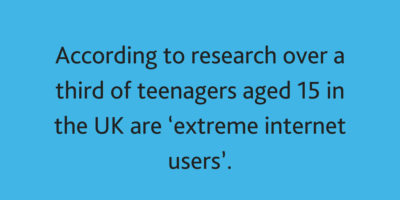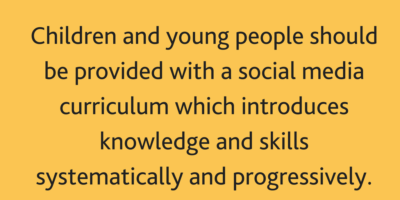During the past decade the growth of social media has enabled people to communicate and share information with a larger audience. Geographical and financial restrictions to communication, networking and knowledge exchange are no longer significant and communication with the online community can be instantaneous.
Social media presents children and young people with exciting opportunities which were once not possible. It is a source of information and support and it provides a social space through which one’s anonymity can be preserved. It permits multi-modal forms of communication and is therefore inclusive of those who struggle to communicate verbally or in social situations. However, whilst everyone has a right to benefit from being online there is a darker side to social media use which warrants serious consideration.
According to Frith’s research over a third of teenagers aged 15 in the UK are ‘extreme internet users’, i.e. they spend more than 6 hours on a typical weekend day on the internet. Additionally, a third of people in the UK were aged 6 years or younger when they first used the internet (Frith, 2017). In 2015 the overwhelming majority (94.8%) of those aged 15 used social media before and after school (Frith, 2017).

We know that young people who spend too long online can experience sleep deprivation and poor sleep quality (Woods and Scott, 2016). This is a serious issue, particularly when minimal sleep is followed by a full day of studying in school. Sleep deprivation impedes concentration in school and can result in deterioration of behaviour. Young people who take their ‘phones to bed with them for fear of missing out on something that is happening in the online world are missing an opportunity for the brain to carry out vital work. Lack of sleep can have a significant affect on processing and consolidating the information which the brain has assimilated during the day.
In addition to sleep deprivation, there is also the issue of online bullying. The PISA research (2015) has found that the longer people spend on-line, they more likely they are to experience cyberbullying. Online bullying is different to traditional face-to-face bullying. Firstly, it can be kept anonymous so that the identity of the perpetrator(s) is kept hidden from the victim. This makes it more difficult to challenge the bullying. Secondly, the abuse is permanently stored online and is revisited on multiple occasions by the victim. Thirdly, the abuse can be viewed by a much larger audience by being repeatedly shared, thus increasing the sense of humiliation that is experienced by the victim.
Social media companies need to do more to challenge online abuse to protect children and young people from psychological distress. Victims tend to respond by self-censoring – they remove themselves from the online world and therefore deny themselves the advantages that social media can bring to their lives. This is not the solution because being online is a right, unless that right is abused.

The OECD has found that excessive internet use can have a negative effect on wellbeing. Worryingly, there has been an increase in the number of websites that encourage children and young people to participate in self-harm. Additionally, the growth in the popularity of ‘selfies’ and the increasing prevalence of photoshopped images of celebrities and other idealised images of beauty can result in body surveillance and lower body esteem (Frith, 2017; Tiggermann and Slater, 2014).
Addressing these issues is urgent but certainly not easy. All teachers, including those in training, need to be better prepared to educate young people about social media. The National Curriculum needs to be reviewed; children and young people should be provided with a social media curriculum which introduces knowledge and skills systematically and progressively. Isolated lessons on e-safety are insufficient to address the issues highlighted here.

The role of parents in managing children and young people’s use of social media should be reviewed by the government. The role of digital media companies in addressing online abuse should also be reviewed, including the use of sanctions in cases where companies do not comply.
Social media is here to stay. Its multiple platforms can bring social, educational and psychological benefits to young people, provided that the risks of psychological distress are minimised. Developing young people’s digital resilience is a step in the right direction but teachers need to understand what this means and what this might look like as a curriculum.
References
Frith, E. (2017), Social Media and Children’s Mental Health: A Review of the Evidence, Education Policy Institute.
PISA (2015) Students’ Wellbeing Volume 111, OECD, April 2016: http://www.oecd.org/edu/pisa-2015-results-volume-iii-9789264273856-en.htm [accessed 22.11.16].
Tiggemann, M. and Slater, A.E., 2013. NetGirls: The Internet, Facebook and body image concern in adolescent girls. International Journal of Eating Disorders, 46(6), 630- 633.
Woods, H, C., and H. Scott, (2016), #Sleepyteens: Social media use in adolescence is associated with poor sleep quality, anxiety, depression and low self-esteem, Journal of Adolescence, 51, 41-49.




